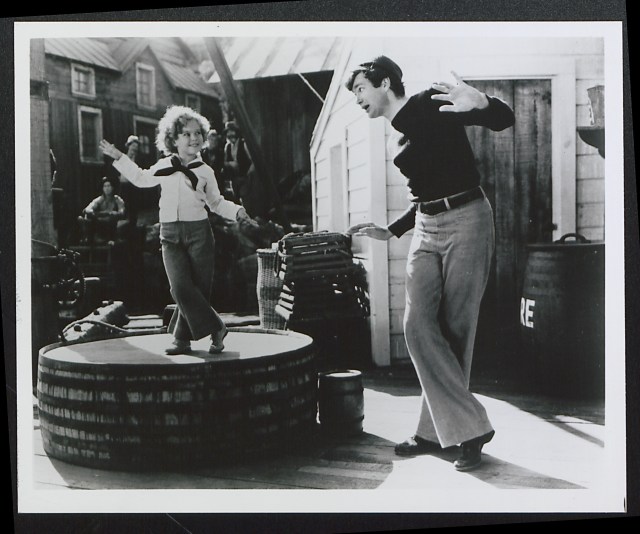Do you remember the TV comedy series The Beverly Hillbillies? How about the mystery series Barnaby Jones? More recently the series King of the Hill? No doubt you’ve seen the classic films The Wizard of Oz or Breakfast at Tiffany’s. Know what they all have in common? Buddy Ebsen.

Buddy Ebsen papers, American Heritage Center, University of Wyoming.
Ebsen, who was both a talented actor and dancer, enjoyed a show business career that spanned more than seventy years. He performed on stage, film, and television and is the subject of an AHC virtual exhibit, “The Entertaining Life of Buddy Ebsen.” The exhibit extends from his early years as a song-and-dance man to his decades as a film and TV star.
Born Christian Ludolf Ebsen, Jr. in Belleville, Illinois, Ebsen moved with his family to Florida at age ten. His father, Christian Ludolf Ebsen, Sr., a former choreographer, ran a dance studio in Orlando, where Ebsen and his four sisters learned to dance. Moving to New York City in the late 1920s, Ebsen and sister Vilma began appearing on stage in the Northeast, ultimately working with Ziegfeld’s Follies.
In 1935, Buddy and Vilma were signed by MGM studios and the two headed to Hollywood. He hoofed it through back-to-back films that include Broadway Melody of 1936 (1935) with Jack Benny, Eleanor Powell, Robert Taylor, and sister Vilma; Captain January (1936) with Shirley Temple; Born to Dance (1936) with Eleanor Powell and Jimmy Stewart; Banjo on My Knee (1936) with Barbara Stanwyck, Joel McCrea, and Walter Brennan; and Broadway Melody of 1938 (1937) with Robert Taylor, Eleanor Powell, George Murphy, and Judy Garland.

Buddy Ebsen papers, American Heritage Center, University of Wyoming.
Ebsen’s big break was on the horizon when he was cast in The Wizard of Oz (1939), first as the Scarecrow and then as the Tin Man. Unfortunately, the aluminum dust in his makeup caused him to suffer major health problems, so much so that he was hospitalized and forced to leave the production. As he explained in his autobiography, The Other Side of Oz, “I had ingested pure aluminum; it had coated my lungs like paint.” For the next fourteen years, Ebsen used nebulizers to help him breathe.

Buddy Ebsen papers, American Heritage Center, University of Wyoming.
A break from the entertainment industry came during World War II when he joined the Coast Guard as an officer. But he returned to Hollywood in the 1950s and was busy once again acting in films such as Night People (1954) with Gregory Peck and Broderick Crawford and Attack (1956) with Jack Palance, Lee Marvin, and Eddie Albert. He took on a serious role in the romantic comedy Breakfast at Tiffany’s (1961) with Audrey Hepburn and George Peppard, where he played Holly’s former husband, Doc Golightly.
Meanwhile, as television was gaining ground in America, so was Ebsen’s career on the small-screen. While continuing his movie and stage acting, he also began appearing on TV in the late 1940s. Notably, his rugged visage was seen in episodes of several popular television westerns, including Maverick, Have Gun–Will Travel, Rawhide, Bonanza, Gunsmoke, and Alias Smith and Jones. In 1955, he co-starred with Fess Parker in the Disney serial Davy Crockett.

Buddy Ebsen papers, American Heritage Center, University of Wyoming.
By 1962, Ebsen had been acting for almost thirty years and was considering retirement. But producer Paul Henning couldn’t imagine anyone but Buddy Ebsen playing an anchor role in his new TV sitcom, The Beverly Hillbillies. For the next nine years, Ebsen performed as Jed Clampett, a hayseed (but nobody’s fool) who strikes oil and, now a wealthy man, moves his family to star-studded Beverly Hills, California. No sooner did Hillbillies end than he was cast as folksy private detective Barnaby Jones in the eponymous television series that ran 1973 to 1980. In 1999, Ebsen made his last television appearance when he voiced aged firefighter Chet Elderson for an episode of the animated program King of the Hill.

Buddy Ebsen papers, American Heritage Center, University of Wyoming.
A Renaissance man, Ebsen also found time to pursue his passions for sailing, singing, and painting. He even published a romance novel at age 92 titled Kelly’s Quest about a rebellious, but standup young actress who flees Hollywood for the Rocky Mountain West to find Mr. Right.
The Buddy Ebsen papers at the AHC, donated by his wife Dorothy Ebsen, contains materials relating to all aspects of Ebsen’s life and his film, stage, and television career. The collection includes correspondence; photographs, clippings; scripts, contracts, and promotional materials from film and television; and stage shows, songs, and music he performed, wrote, or co-wrote. Also included are documents and artifacts relating to his hobby of sailing and artwork created by Ebsen.
Like Ebsen’s papers, the exhibit features highlights from all areas of his career.
The entirety of the Buddy Ebsen papers (more than 165 cubic feet) is available for research at the American Heritage Center.
Post contributed by AHC Processing Archivist Roger Simon with contributions by Simpson Archivist Leslie Waggener.
#alwaysarchiving


I thoroughly n’joyed this !
Well done, I am looking forward to see the exhibit !
See you soon!